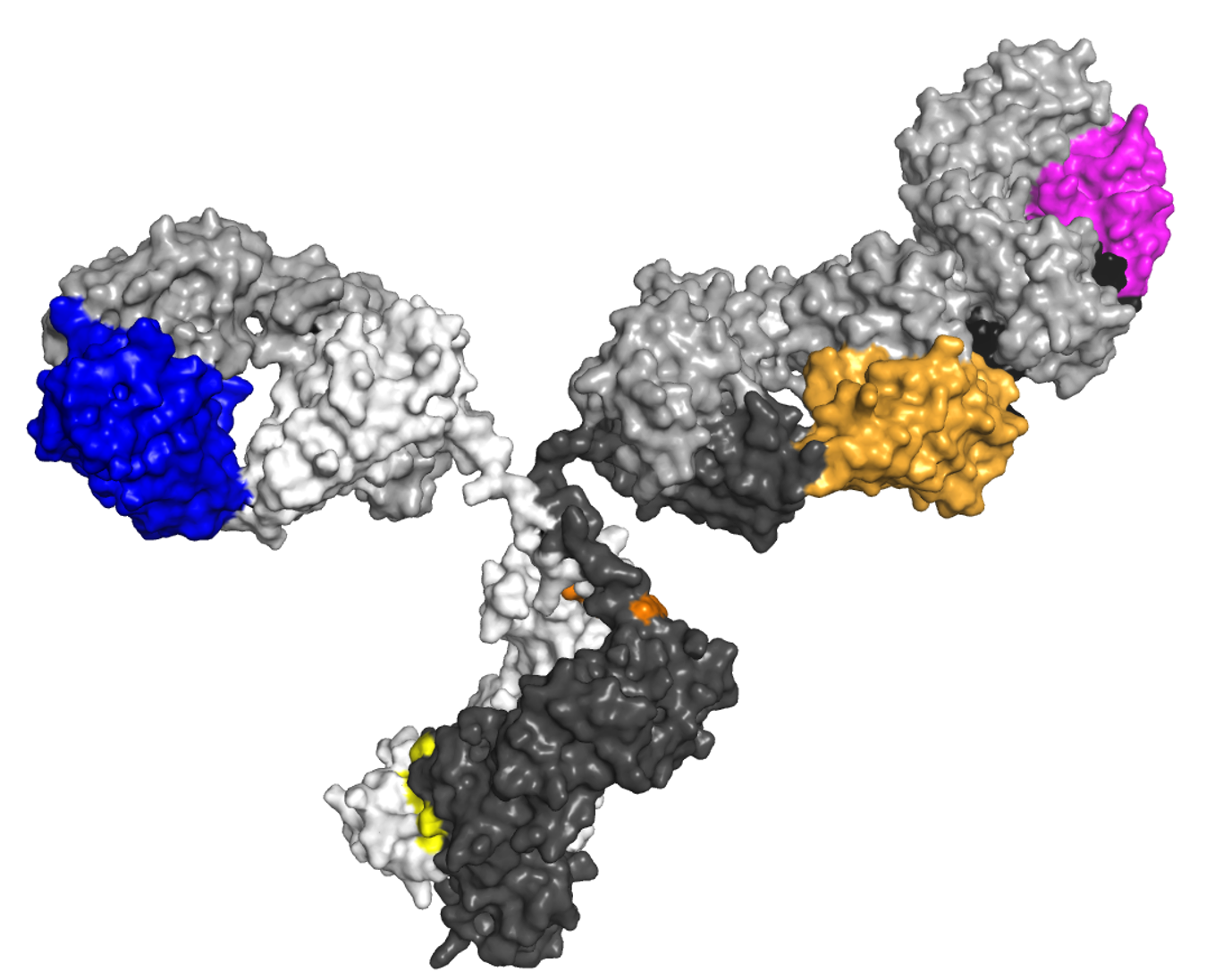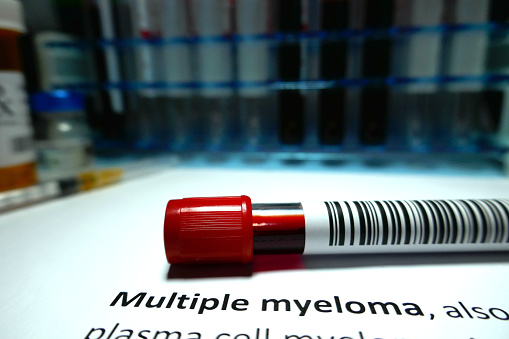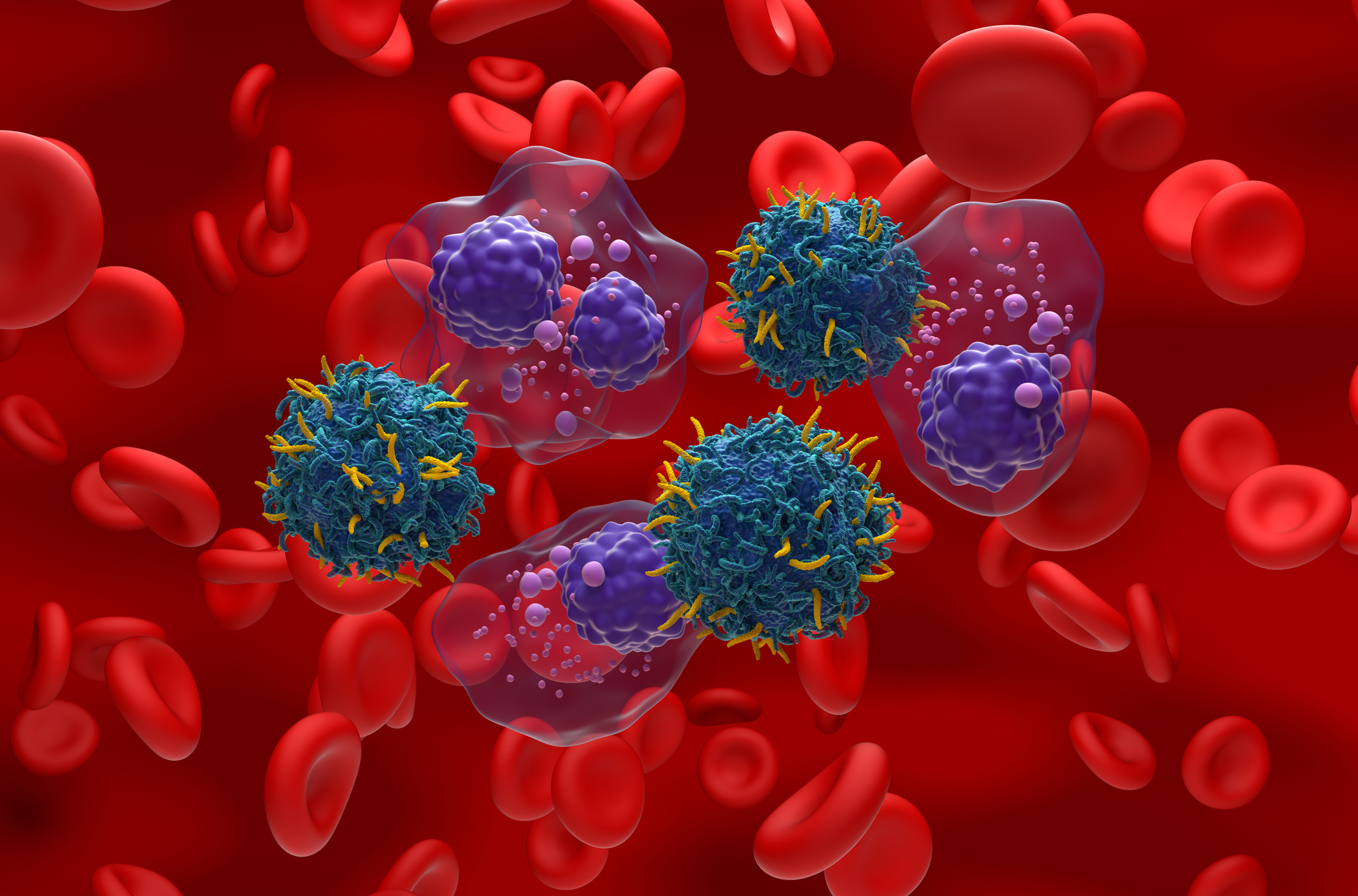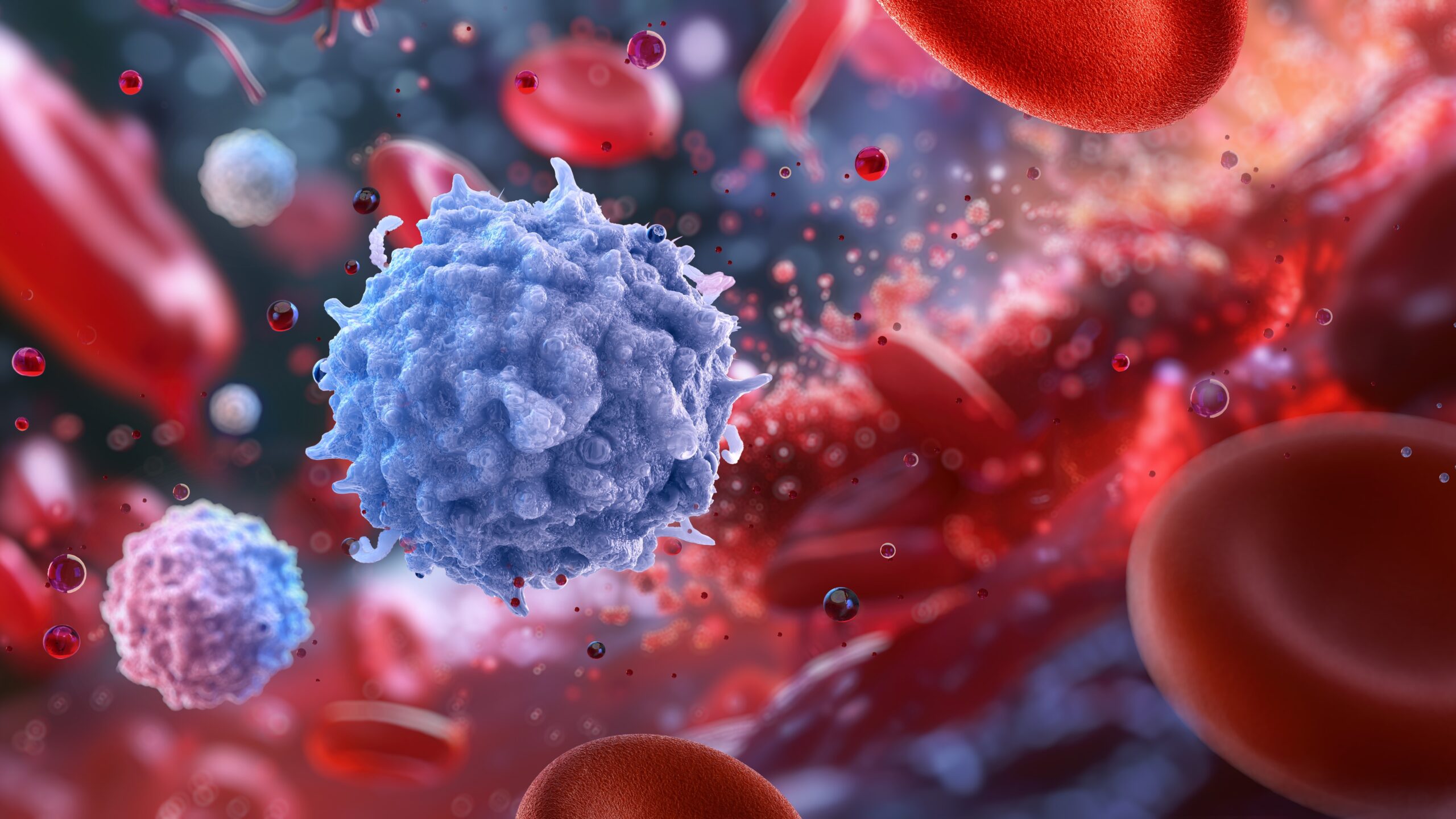
Multiple myeloma (MM), the second most common hematologic malignancy, is consistently preceded by the asymptomatic expansion of clonal plasma cells, termed either monoclonal gammopathy of undetermined significance (MGUS) or smoldering myeloma (SMM).1-6 These 2 clinically defined precursor conditions, introduced into the literature more than 40 years ago,7,8 can be found in 2-3% of the adult general population. Only a small fraction of MGUS cases will ultimately progress to MM, whereas approximately 65% of individuals diagnosed with SMM will progress within 10 years of initial diagnosis.2,4
The differentiation between the two clinical entities MGUS and SMM is currently based on indirect measures and surrogate markers of disease burden (arbitrary cut-offs of percentage of abnormal plasma cells in the bone marrow and concentration of abnormal serum protein in peripheral blood).5,6 While these clinical terminologies are reasonably accurate in defining a SMM high-risk disease group and its average risk of progression,9 they perform considerably less well in predicting risk for the group of patients with low disease burden (e.g., intermediate- and low-risk SMM).
According to current clinical consensus, the standard of care for SMM is close observation without treatment until end-organ damage develops. The first randomized clinical trial conducted to investigate whether early initiation of therapy (melphalan-prednisone versus observation) in SMM improved clinical outcomes was reported in 1993.10 However melphalan-prednisone was not found to delay progression to MM or to improve overall survival (OS) and, over the following 20 years, observation remained the default treatment paradigm for SMM.11
In 2013, the first randomized phase III trial using a novel drug, the QuiRedex study, reported that lenalidomide significantly increased time to progression to MM and survival versus observation,12 as did the subsequent (Eastern Cooperative Oncology Group (ECOG) E3A06 study.13 Together, these proof-of-concept studies supported investigating interventional treatment for SMM using novel multidrug regimens.
Today there are 2 main philosophical approaches to clinical trials targeting so-called high-risk SMM: one is delaying development of MM by reverting to an MGUS-like phenotype, and the other involved taking advantage of a potentially more treatment-sensitive biology in early disease to (functionally) eradicate the myeloma clone.14 The 2 lenalidomide-based (with or without dexamethasone) randomized studies, QuiRedex and E3A06, represent the approach that attempted to delay the development of MM. Similarly, the randomized phase II CENTAURUS study investigated whether monotherapy with daratumumab, a monoclonal CD38-targeted antibody, could reduce the risk of progression to MM.15
These 3 clinical trials confirmed that starting therapy (versus observation) delays the onset of MM.12,13,15 However many questions remained unanswered, including the role of lead-time bias and the impact on overall survival (OS), quality of life, and costs. In support of the second treatment approach (i.e., seeking to eradicate MM), the first study of a three-drug combination study in high-risk SMM was carried out by the US National Cancer Institute (NCI), using carfilzomib, lenalidomide, and dexamethasone (KRd) (NCT01572480).16 Among these patients the MRD negative CR rate was 70%, with a median sustained duration of 5.5 years.
The 8-year probability of being free from progression to MM was 91%. Motivated by the NCI study, other groups have initiated studies based on the KRd backbone. For example, in the ongoing GEM-CESAR study, high-dose melphalan with transplant has been added to the KRd regimen. Preliminary results showed a CR or better rate of 76% and an undetectable MRD rate of 63% after consolidation (N=83), which appears similar to the NCI study, despite the use of transplant in GEM-CESAR.17 In the ongoing ASCENT study, daratumumab has been added to the KRd backbone with efficacy results pending.18
Until recently, there have been limited efforts focusing on comprehensive genomic characterization of early MM. In 2019 and 2020, we were able to characterize, for the first time, several new driver events in MM, such as: 81 mutations in driver oncogenes, more than 100 recurrent copy number aberrations, 69 hotspots of structural variants, and 9 mutational processes involved in shaping MM mutational profile.19-21 We have also identified several genomic mechanisms through which MM acquires these drivers and aberrations essential for cancer progression. Specifically, we identified three main complex structural events, chromothripsis, chromoplexy, and templated insertions involving more than 2 chromosomes, in 63% of all cases (24%, 11%, and 19%, respectively), and showed that they are critical to disease progression and therapy resistance.21 All these events together compose the catalogue of “myeloma genomic defining events.” This breakthrough allowed our study team to interrogate, for the first time, the whole genome sequencing profile of MM precursor conditions (MGUS and SMM) characterized by low burden of abnormal cells.22 Taking this approach in a pilot study (n = 32), we identified a genomic signature for patients who are genomically programmed to progress to MM (over 90% progressed within 5 years) versus remain stable.22 It seems reasonable to conjecture that these novel observations – the introduction of “myeloma genomic defining events” – will transform the field of MM. We have already launched a large program to expand our findings. In 2022, we will open enrollment for a new study offering therapy for individuals with MGUS and SMM who have myeloma genomic defining events, with an overall goal to seek a cure for MM.
Author Bio:
C. Ola Landgren, MD, PhD is Professor of Medicine, Chief of Myeloma Program, Leader of Experimental Therapeutics Program at Sylvester Comprehensive Cancer Center at University of Miami (SCCC-UM). Over the past several years, he designed and conducted a series of studies to define biological mechanisms of transformation from myeloma precursor disease (monoclonal gammopathy of undetermined significance [MGUS] and smoldering myeloma) to multiple myeloma. Beyond traditional clinical criteria for complete remission, he developed strategies to define minimal (measurable) residual disease (MRD) detection post-therapy in multiple myeloma using cell-, molecular-, and imaging-based methods. He has a strong track-record in drug development and served as a principal investigator for many clinical trials, with particular focus on early drug development and correlative science. He leads the clinical and research operations along with the development of the Myeloma Program at SCCC-UM. He is a frequent speaker and faculty member for national and international meetings on myeloma and hematologic malignancies. He is a member of several editorial boards and serves as a reviewer for grants and several high-impact journals. As a Program Member of the Cancer Center Support Grant, he participates in research activities as an independent investigator, a leader of research governance committees, and on multi-disciplinary research teams.
- Landgren O, Weiss BM. Patterns of monoclonal gammopathy of undetermined significance and multiple myeloma in various ethnic/racial groups: support for genetic factors in pathogenesis. Leukemia. 2009;23(10):1691-1697. DOI: 10.1038/leu.2009.134
- Kyle RA, Larson DR, Therneau TM, et al. Long-term follow-up of monoclonal gammopathy of undetermined significance. N Engl J Med.2018;378(3):241-249. DOI: 10.1056/NEJMoa1709974
- Kyle RA, Remstein ED, Therneau TM, et al. Clinical course and prognosis of smoldering (asymptomatic) multiple myeloma. N Engl J Med. 2007;356(25):2582-2590. DOI: 10.1056/NEJMoa070389
- Kyle RA, Therneau TM, Rajkumar SV, et al. Prevalence of monoclonal gammopathy of undetermined significance. N Engl J Med. 2006;354(13):1362-1369. DOI: 10.1056/NEJMoa054494
- Maura F, Bolli N, Rustad EH, et al. Moving From cancer burden to cancer genomics for smoldering myeloma: a review. JAMA Oncol. 2020;6(3):425-432. DOI: 10.1001/jamaoncol.2019.4659
- Rajkumar SV, Landgren O, Mateos MV. Smoldering multiple myeloma. Blood. 2015;125(20):3069-3075. DOI: 10.1182/blood-2014-09-568899
- Kyle RA. Monoclonal gammopathy of undetermined significance. Natural history in 241 cases. Am J Med. 1978;64(5):814-826. DOI: 10.1016/0002-9343(78)90522-3
- Kyle RA, Griepp PR. Smoldering multiple myeloma.N Engl J Med. 1980 Jun 12;302(24):1347-1349. DOI: 10.1056/NEJM198006123022405
- Rajkumar SV, Dimopoulos MA, Palumbo A, et al. International Myeloma Working Group updated criteria for the diagnosis of multiple myeloma. Lancet Oncol. 2014;15(12):e538-e548. DOI: 10.1016/S1470-2045(14)70442-5
- Hjorth M, Hellquist L, Holmberg E, et al; Myeloma Group of Western Sweden. Initial versus deferred melphalan-prednisone therapy for asymptomatic multiple myeloma stage I—a randomized study. Eur J Haematol.1993;50(2):95-102. DOI: 10.1182/blood-2014-09-568899
- Hill E, Dew A, Kazandjian D. State of the science in smoldering myeloma: Should we be treating in the clinic? Semin Oncol. 2019;46(2):112-120. DOI: 10.1053/j.seminoncol.2019.03.001
- Mateos MV, Hernández MT, Giraldo P, et al. Lenalidomide plus dexamethasone for high-risk smoldering multiple myeloma. N Engl J Med. 2013;369(5):438-447. DOI: 10.1056/NEJMoa1300439
- Lonial S, Jacobus S, Fonseca R, et al. Randomized trial of lenalidomide versus observation in smoldering multiple myeloma. J Clin Oncol. 2020;38(11):1126-1137. DOI: 10.1200/JCO.19.01740
- Lomas OC, Ghobrial IM. Clinical controversies in the management of smoldering multiple myeloma. Am Soc Clin Oncol Educ Book. 2020:40:314-319. DOI: 10.1200/EDBK_278911
- Landgren CO, Chari A, Cohen YC, et al. Daratumumab monotherapy for patients with intermediate-risk or high-risk smoldering multiple myeloma: a randomized, open-label, multicenter, phase 2 study (CENTAURUS). Leukemia. 2020;34(7):1840-1852. DOI: 10.1038/s41375-020-0718-z
- Kazandjian D, Hill E, Morrison C, et al. Treatment of high risk (HR) smoldering multiple myeloma (SMM) with carfilzomib, lenalidomide, and dexamethasone (KRd) followed by lenalidomide maintenance (-R): a phase 2 clinical and correlative study Blood. 2020;136 (Suppl 1):43–45. Abstract 548. DOI: 10.1182/blood-2020-136148
- Mateos M-V, Martinez-Lopez J, Rodriguez Otero P, et al. Curative strategy (GEM-CESAR) for high-risk smoldering myeloma (SMM): carfilzomib, lenalidomide and dexamethasone (KRd) as induction followed by HDT-ASCT, consolidation with Krd and maintenance with Rd. Blood. 2019;134(suppl 1):781. DOI: 10.1182/blood-2019-125204
- Kumar SK, Abdallah A-O, Badros AZ, et al. Aggressive Smoldering Curative approach Evaluating Novel Therapies (ASCENT): A phase 2 trial of induction, consolidation and maintenance in subjects with high risk smoldering multiple myeloma (SMM): initial analysis of safety data. Blood.2020;136(suppl 1):35-36. DOI: 10.1182/blood-2020-142584
- Maura F, Bolli N, Angelopoulos N, et al. Genomic landscape and chronological reconstruction of driver events in multiple myeloma.Nat Commun. 2019;10(1):3835. DOI: 10.1038/s41467-019-11680-1
- Maura F, Rustad EH, Yellapantula V, et al. Role of AID in the temporal pattern of acquisition of driver mutations in multiple myeloma. Leukemia. 2020;34(5):1476-1480. DOI: 10.1038/s41375-019-0689-0
- Rustad EH, Yellapantula VD, Glodzik D, et al. Revealing the impact of structural variants in multiple myeloma. Blood Cancer Discov. 2020;1(3):258-273. DOI: 10.1158/2643-3230.bcd-20-0132
- Oben B, Froyen G, Maclachlan KH, et al. Whole-genome sequencing reveals progressive versus stable myeloma precursor conditions as two distinct entities. Nat Commun.2021;12(1):1861. DOI: 10.1038/s41467-021-22140-0
Disclosures
Dr Landgren has received grant support from: LLS, Rising Tide Foundation, NIH, FDA, MMRF, IMF, Riney Family Foundation, Perelman Family Foundation, Amgen, Celgene, Janssen, Takeda, Glenmark, Seattle Genetics, Karyopharm; has received honoraria for scientific talks/participated in advisory boards for: Adaptive, Amgen, Binding Site, BMS, Celgene, Cellectis, Glenmark, Janssen, Juno, Pfizer; and has served on Independent Data Monitoring Committees (IDMC) for international randomized trials by: Takeda, Merck, Janssen, and Theradex.






 © 2025 Mashup Media, LLC, a Formedics Property. All Rights Reserved.
© 2025 Mashup Media, LLC, a Formedics Property. All Rights Reserved.